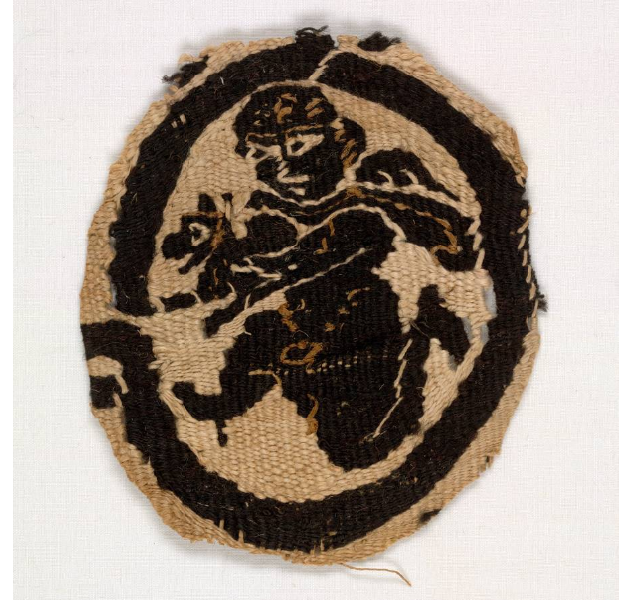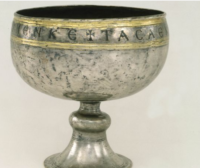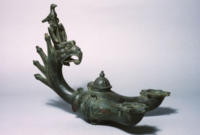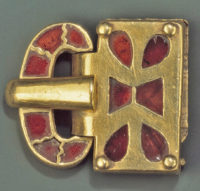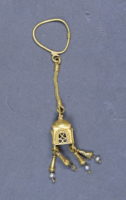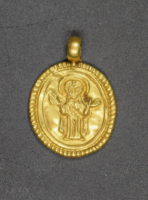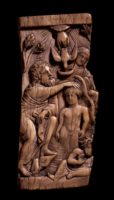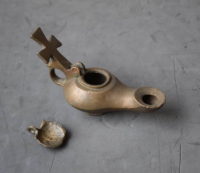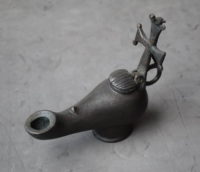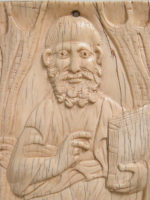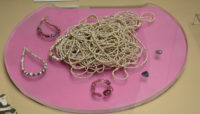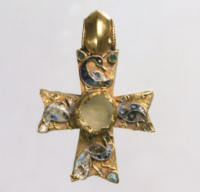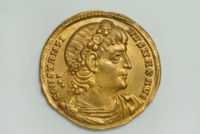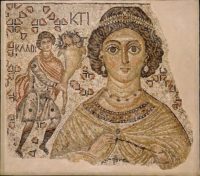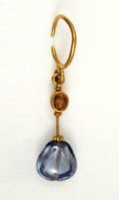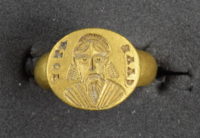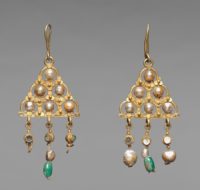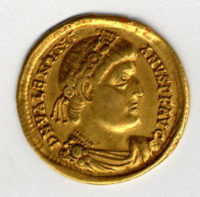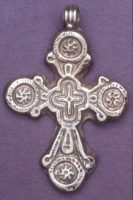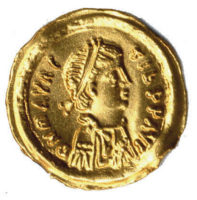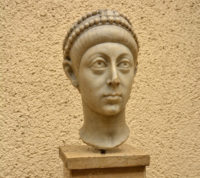Fragment with Running Figure, Materials: tapestry; linen and wool, Period: Early Byzantine circa: 500s. The Cleveland Art Museum Hours: Tuesdays, Thursdays, Saturdays, Sundays 10:00 a.m.–5:00 p.m. Wednesdays, Fridays 10:00 a.m.–9:00 p.m. Closed Mondays.
Chalice, Period: Early Byzantine, ca. 527 – 565 A.D. Materials: silver and niello. The museum is open to the public Tuesday through Sunday, 11:30 a.m.–5:30 p.m., except for federal holidays.
Griffin’s Head Lamp, Period: Early Byzantine, circa 4th-5th century. Purchased from George Zacos (dealer), Istanbul by Dumbarton Oaks Research Library and Collection, Washington, DC, July 1962. The museum is open to the public Tuesday through Sunday, 11:30 a.m.–5:30 p.m., except for federal holidays.
Buckle with Garnets. Period: Early Byzantine; circa:400–500 A.D. Material: gold. Made in: Constantinople. The Metropolitan Museum of Art (New York) is one of the world’s largest and finest art museums. Its collection includes more than two million works of art spanning five thousand years of world culture, from prehistory to the present and from every part of the globe. Public Hours: 10:30 a.m.–5:30 p.m. Open seven days a week.
Gold Earring; Period: Early Byzantine; consisting of a tower-like ornament attached to a gold chain; circa: 5thC-6thC, Early Byzantine. Found: Kalymnos, Greece. British Museum is closed 24, 25 and 26 December and 1 January, but is open every other day of the year. Fast facts about the British Museum: Founded: 1753, Collection size: 8 million objects, Oldest object in the collection: Stone chopping tool (nearly 2 million years old).
Gold Oval Pendant; embossed with a figure of the Virgin standing in the attitude of an orans within a pearled border. Findspot: Nile Delta, Alexandria, Egypt. Period: Early Byzantine. British Museum is closed 24, 25 and 26 December and 1 January, but is open every other day of the year. Fast facts about the British Museum: Founded: 1753, Collection size: 8 million objects, Oldest object in the collection: Stone chopping tool (nearly 2 million years old).
Ivory Panel, Period: Early Byzantine, circa: 6th c. Made in: Syria. Dimensions: Height: 16.3 centimetres Width: 8.1 centimetres Depth: 1 centimetres Weight: 128 grammes. Carved in relief with a depiction of The Baptism: young Christ standing full face up to waist in water; to left, St John the Baptist stands leaning forward upon a rock, one hand resting upon Christ’s head. British Museum is closed 24, 25 and 26 December and 1 January, but is open every other day of the year. Fast facts about the British Museum: Founded: 1753, Collection size: 8 million objects, Oldest object in the collection: Stone chopping tool (nearly 2 million years old).
Lamp, Period: Early Byzantine, circa: 6th-7th c. Materials: Bronze. Found: Edfu, great church (Upper Egypt,Edfu) British Museum is closed 24, 25 and 26 December and 1 January, but is open every other day of the year. Fast facts about the British Museum: Founded: 1753, Collection size: 8 million objects, Oldest object in the collection: Stone chopping tool (nearly 2 million years old).
Lamp, Made in: Luxor, Egypt. Period: Early Byzantine circa: 6th-7th century. Subjects: Cross, bird. Found/Acquired: Luxor. Materials: Bronze. British Museum is closed 24, 25 and 26 December and 1 January, but is open every other day of the year. Fast facts about the British Museum: Founded: 1753, Collection size: 8 million objects, Oldest object in the collection: Stone chopping tool (nearly 2 million years old).
Panel with St. Peter or St. Paul, Period: Early Byzantine circa: 500s, Made in Byzantine Egypt, Materials: Ivory. Dimensions: 9 1/8 x 4 1/8 x 5/16 in. (23.1 x 10.5 x 0.8 cm). On view at The Met Fifth Avenue in Gallery 300. The Metropolitan Museum of Art (New York) is one of the world’s largest and finest art museums. Its collection includes more than two million works of art spanning five thousand years of world culture, from prehistory to the present and from every part of the globe. Public Hours: 10:30 a.m.–5:30 p.m. Open seven days a week.
Quantity of pearl, tourmaline, glass, coral and bronze beads, once attached no doubt to cloth. Period: Early Byzantine circa: 6-7th century. Made in/Findspot: Constantinople. In the Istanbul Archaeological Museum collections, there are rich and very important works of art belonging to various civilizations from the regions from Africa to Balkans , from Anatolia and Mesopotamia to Arab Peninsula and Afghanistan that were in the borders of the Ottoman Empire.
Pendant Cross with Birds and Zoe-Phos, Period: Early Byzantine, circa Late 6th Century. Materials: filigree enamel on gold. The museum is open to the public Tuesday through Sunday, 11:30 a.m.–5:30 p.m., except for federal holidays.
Solidus of Constantine I (306–337), Material: Gold. The museum is open to the public Tuesday through Sunday, 11:30 a.m.–5:30 p.m., except for federal holidays.
Fragment of a Floor Mosaic with a Personification of Ktisis, Period: Early Byzantine circa: 500–550, with modern restoration. Materials: Marble and glass. The Metropolitan Museum of Art (New York) is one of the world’s largest and finest art museums. Its collection includes more than two million works of art spanning five thousand years of world culture, from prehistory to the present and from every part of the globe. Public Hours: 10:30 a.m.–5:30 p.m. Open seven days a week.
Earring with Emerald and Sapphire, Period: Early Byzantine circa: early 5th century. Size: 6.5 (2.6). Material: gold and gems. Found in 1910 during restoration work in Piazza della Consolazione, Rome. The museum is open to the public Tuesday through Sunday, 11:30 a.m.–5:30 p.m., except for federal holidays.
Gold Signet-Ring, plain hoop and applied oval bezel depicts bust of Christ(?). Period: Late Roman – Early Byzantine. 5thC-6thC. Found/Acquired: Rome. British Museum is closed 24, 25 and 26 December and 1 January, but is open every other day of the year. Fast facts about the British Museum: Founded: 1753, Collection size: 8 million objects, Oldest object in the collection: Stone chopping tool (nearly 2 million years old).
Earrings (pair), Period: Early Byzantine; circa: 600s; Materials: gold, pearls, glass, and emeralds. The Cleveland Art Museum Hours: Tuesdays, Thursdays, Saturdays, Sundays 10:00 a.m.–5:00 p.m. Wednesdays, Fridays 10:00 a.m.–9:00 p.m. Closed Mondays.
Gold Solidus of Valentinian I (364–75), Made in Nicomedia (Modern Izmit, Turkey), Material: Gold. Valentinian restored Christian symbols, including the Chi-Rho emblem atop the emperor’s standard. On view at The Met Fifth Avenue in Gallery 301. The Metropolitan Museum of Art (New York) is one of the world’s largest and finest art museums. Its collection includes more than two million works of art spanning five thousand years of world culture, from prehistory to the present and from every part of the globe. Public Hours: 10:30 a.m.–5:30 p.m. Open seven days a week.
Pendant Cross, Period: Early Byzantine (7thc.) Height: 55.8 millimetres Width: 37.2 millimetres Depth: 7 millimetres Weight: 7.27 grammes. Materials: Gold. British Museum is closed 24, 25 and 26 December and 1 January, but is open every other day of the year. Fast facts about the British Museum: Founded: 1753, Collection size: 8 million objects, Oldest object in the collection: Stone chopping tool (nearly 2 million years old).
Tremissis of Emperor Maurice Tiberius, Period: ca. 582–602, Early Byzantine, Material: Gold. On view at The Met Fifth Avenue in Gallery 301. The Metropolitan Museum of Art (New York) is one of the world’s largest and finest art museums. Its collection includes more than two million works of art spanning five thousand years of world culture, from prehistory to the present and from every part of the globe. Public Hours: 10:30 a.m.–5:30 p.m. Open seven days a week.
Bust of Emperor Arcadius, Period: Early Byzantine circa: late 4th. century. Made in/Findspot: Constantinople (Modern Turkey; Beyazit, Istanbul) Materials: Marble. In the Istanbul Archaeological Museum collections, there are rich and very important works of art belonging to various civilizations from the regions from Africa to Balkans, from Anatolia and Mesopotamia to Arab Peninsula and Afghanistan that were in the borders of the Ottoman Empire.


